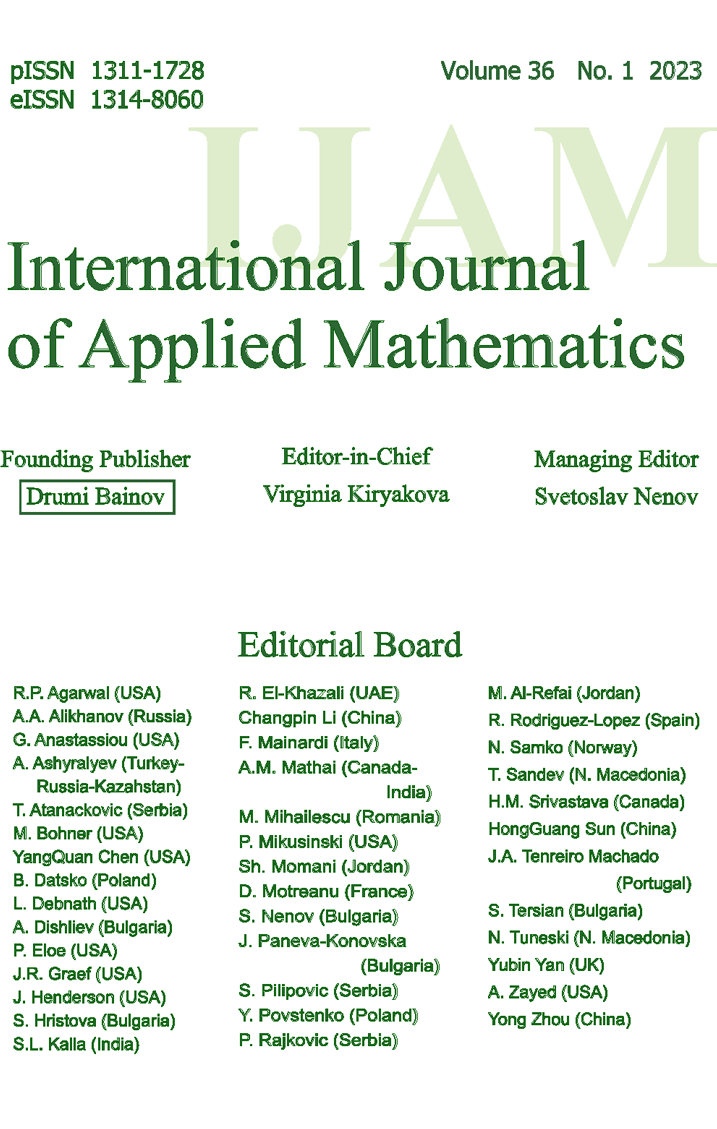ANALYSIS OF SPATIAL NONLINEAR
SYSTEMS OF DIFFUSION TYPE WITH DELAY
SYSTEMS OF DIFFUSION TYPE WITH DELAY
Abstract
A spatial mathematical model of biological wastewater treatment depending on the system temperature is presented. The model investigates the relationship between the characteristics of the processes occurring at the treatment plant and offers an algorithm to solve the relevant feature of the perturbation problem and describes the process itself. The graphical relationships and dependencies between the process parameters obtained in the process of work are effective for further theoretical research aimed at optimizing the parameters of the cleaning process, namely: loading time, filter size, etc. In the process of filtration, the shape of the filter plays a significant role because it affects the performance by increasing or decreasing the filtration capacity. The influence of external factors on temperature calculations on the basis of heat transfer equations and laws of thermodynamics is investigated. The effect of water temperature and oxygen concentration on the ability to absorb activated sludge was studied. The results of the distribution of the concentration of contaminants and the temperature field during the purification of the liquid are presented. The dependence of bacterial activity on water temperature has been studied, which allows to increase the accuracy of forecasting and to develop the automation of the biological wastewater treatment process.Citation details of the article
Journal: International Journal of Applied Mathematics Journal ISSN (Print): ISSN 1311-1728
Journal ISSN (Electronic): ISSN 1314-8060
Volume: 34 Issue: 5 Year: 2021 DOI: 10.12732/ijam.v34i5.9
Download Section
Download the full text of article from here.
You will need Adobe Acrobat reader. For more information and free download of the reader, please follow this link.
References
- [1] A. Bomba, A. Safonyk, V. Voloshchuk, Spatial modeling of multicomponent pollution removal for liquid treatment under identification of mass transfer coefficient, Mathematical Modeling and Computing, 5, No 2 (2018), 108–118; doi: 10.23939/mmc2018.02.108.
- [2] A. Safonyk, S. Martynov, S. Kunytskyi, Modeling of the contact removal of iron from groundwater, International Journal of Applied Mathematics, 32, No 1 (2019), 71–82; doi: 10.12732/ijam.v32i1.7.
- [3] A. Safonyk, I. Tarhonii, A. Rudyk, I. Hrytsiuk, Modeling, analysis and automation of wastewater treatment by electrocoagulation method, Advanc. in Intell. Sys. and Com., Lect. Not. in Comp. Intell. and Dec. Making, 1246 (2021), 597–611; doi: 10.1007/978-3-030-54215-3-38.
- [4] A. Safonyk, A. Bomba, I. Tarhonii, Modeling and automation of the electrocoagulation process in water treatment, Advances in Intelligent Systems and Computing, 871 (2019), 451–463; doi: 10.1007/978-3-030-01069-0-32.
- [5] A. Safonyk, O. Prysiazhniuk, Modeling and simulation in engineering modeling of the electrocoagulation processes in nonisothermal conditions, Modelling and Simulation in Engineering, (2019); # 9629643; doi: 10.1155/2019/9629643.
- [6] A. Safonyk, S. Martynov, S. Kunytsky, O. Pinchuk, Mathematical modelling of regeneration the filtering media bed of granular filters, Advances in Modelling and Analysis, 73, No 2 (2018), 72–78; doi: 10.18280/amac. 730206.
- [7] A. Safonyk, O. Hrytsyna, V. Voloshchuk, V. Sereda, Mathematical modelling of heat and mass transfer processes in wastewater biological treatment systems, Bulgarian Chemical Communications, 50 (2018), 70–75.
- [8] C. D. Knightes, C. A. Peters, Statistical analysis of nonlinear parameter estimation for monod biodegradation kinetics using bivariate data, Biotechnol. Bioeng., 69, No 2 (2000), 160–170; doi: 10.1002/(sici)10970290(20000720)69:2<160::aid-bit5>3.0.co;2-j.
- [9] C. Dong-Hyun, R. McNamara, M. Y. Kim, K.Y. Park, C. Park, Investigation of the sludge reduction mechanism in the anaerobic sidestream reactor process using several control biological wastewater treatment processes, Water Research, 45, No 18 (2011), 6021–6029; doi: 10.1016/j.watres.2011.08.051.
- [10] D. Dochain, Peter A. Vanrolleghem, Dynamical modelling and estimation in wastewater treatment processes, IWA Publishing, (2001); doi: 10.2166/9781780403045.
- [11] F. Gao, J. Nan, S. Li, Y. Wang, Modeling and simulation of a biological process for treating different cod:n ratio wastewater using an extended asm1 model. Chemical Engineering Journal, 332 (2018), 671–681; doi: 10.1016/j.cej.2017.09.137.
- [12] G. Quijano, J. S. Arcilaa, G. Buitr´ona, Microalgal-bacterial aggregates: applications and perspectives for wastewater treatment biotechnol, Biotechnology Advances, 35, No 6 (2017), 772–781; doi: 10.1016/j.biotechadv.2017.07.003.
- [13] Henze, M., Activated sludge models, ASM1, ASM2, ASM2d and ASM3, Scientific and technical report, IWA Publishing, 9 (2000); doi: 10.2166/9781780402369.
- [14] Pauli, A., Integrated two-phase purification procedure for abatement of pollutants from sanitary landfill leachates, Chemical Engineering Journal, 334 (2018), 19–29; doi: 10.1016/j.cej.2017.10.028.
- [15] Y. Liu, H. H. Ngo, W. Guo, L. Peng, D. Wang, B. Ni, The roles of free ammonia (fa) in biological wastewater treatment processes: A review, Environment International, 123 (2019), 10–19; doi: 10.1016/j.envint.2018.11.039.
- [16] A. Safonyk, V. Garashchenko, O. Garashchenko, Mathematical modelling process of liquid filtration taking into account reverse influence of process characteristics on medium characteristics, International Journal of Applied Mathematics, 33, No 1 (2020), 50–58; doi: 10.12732/ijam.v33i1.5.

